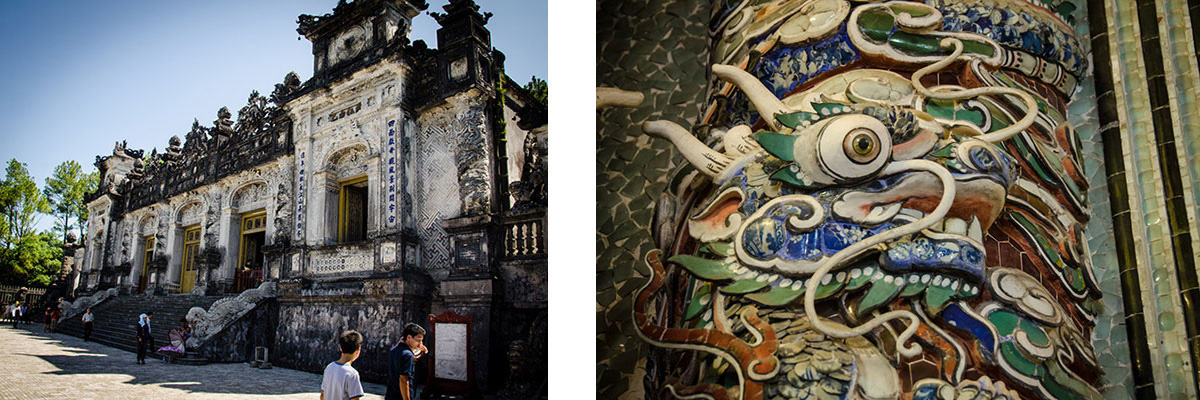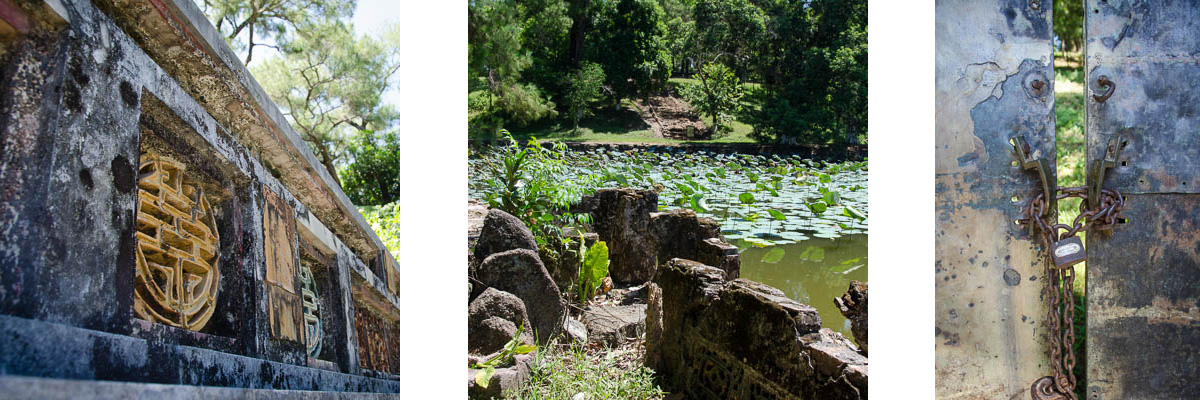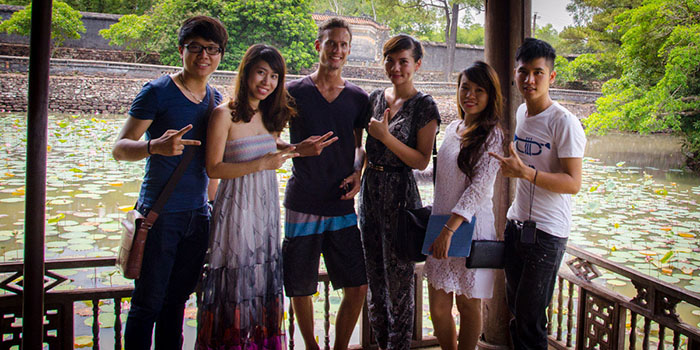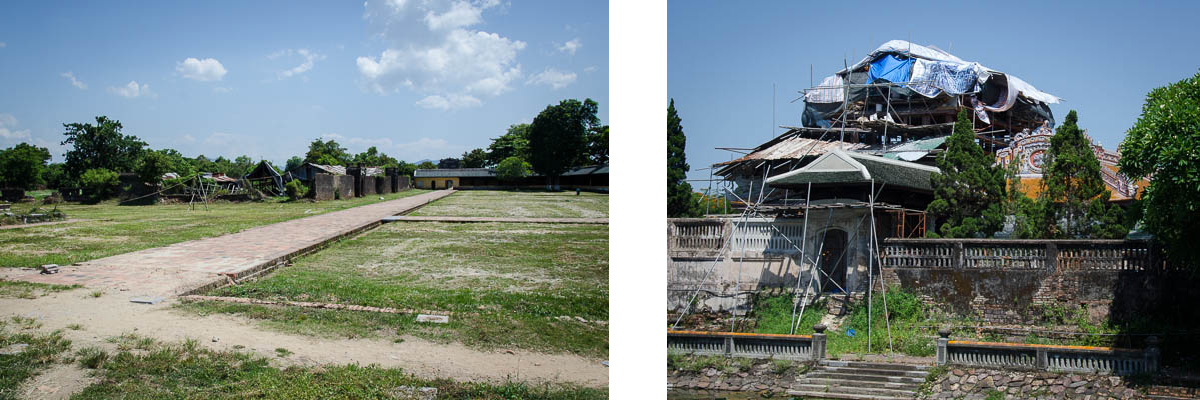Hue City Tour

During the nineteenth and the first half of the twentieth century Vietnam the Nguyen dynasty ruled over Vietnam. The emperors of this family lived in Hue and resided in a ‘forbidden city’ akin to the one in Beijing. From Da Nang I travel on one of the most scenic railroads in the world to have a look at the former capital and the tombs of the emperors spread out around the city.
It is only a short distance from Da Nang to Hue and the views are spectacular as the train winds along the coast giving beautiful views on golden beaches. The air-conditioning in the train is having a hard time keeping the carriage at a reasonable temperature so I contemplate jumping from the train and spending the rest of the day on one of these deserted beaches. Taking pictures from a moving train doesn't do justice to the views itself so I suggest to just visit Vietnam and have a look for yourself. Only two hours after leaving Da Nang we roll into the train station of Hue.
Summer in Vietnam: Busy Trains
Before I check in to my hotel in Hue I want to buy a train ticket for the next leg in my journey, from Hue to the current capital of Vietnam, Hanoi. To speed up the booking process I prepare myself by selecting the trains I want to travel on and I enter this data in the notes app on my smartphone so I can show this to the lady behind the counter as communication in English is limited and my Vietnamese is also lacking. Up to now I had no problems securing the seats I was after but my luck seems to have run out. As in Europe it is summer holiday in Vietnam and this is the time many Vietnamese take the train to go on a holiday or visit family. As a consequence most seats are already taken for the date I want to travel. In some trains there are hard seats available, but sitting on a wooden bench for sixteen hours does not sound very appealing to me. The woman behind the counter not being very helpful I decide to regroup and have another look at my options. The moment I leave the line I am approached by a man offering bus tickets, but this would mean already giving up on my plan to do this whole journey by train so I decline his offer. After looking at my options I decide to queue in a different line and be more flexible with trains and dates and with the help of a friendly Vietnamese translating my questions for the lady behind the counter I manage to secure a soft seat on the date I initially wanted to travel. With this train ticket in my pocket I jump in a taxi to my hotel.
For the next day I arrange a private motorbike tour to explore the history in and around Hue. I choose a private tour over an organized bus tour because I prefer fresh air over an air-conditioned bus and this way I can explore the sights at my own pace. A cheaper way would be to rent a bicycle or a motorbike and drive to the tombs myself but the lack of maps and signs makes this difficult; having someone else drive me around also allows me to enjoy the scenery without having to navigate the frantic traffic at the same time.
The price of this motorbike tour was 17 USD; for comparison: a group tour by bus costs around 12 USD. None of these tours include the entrance fees to the tombs (80.000 VND each) or the citadel (105.000 VND). Note that these are the entrance fees for foreigners, Vietnamese pay less. My general impression is that Hue is an overpriced tourist attraction but I do not regret visiting the city and the tombs while I was there.
Exploring the Emperor's Tombs
The three tombs I visited are the most popular and best maintained ones. There are more tombs hidden in the jungle but some of them are in very bad shape; we drove past one that was not more than a bunch of stones overgrown by jungle.

First tomb on the list is the tomb of Khai Dinh, who was emperor from 1916 until his death in 1925. Khai Dinh was not very popular as emperor but his tomb nowadays is a very popular spot for Asian tourists. I have been told that the architecture of this tomb in particular is interesting because it is a mix of Asian and European architecture. My eye for architecture is not very well developed but I could definitely see that this one is the least ‘Asian’ of the tombs I have seen.

Next I went to the tomb of Minh Mang which I found the best of the lot, in part because it was really quiet when I visited. The ‘design’ of this tomb features a lot of water and green and the buildings fit nicely in the landscape; the whole complex is very symmetrically laid out. Constructed between 1840 and 1843 this is the oldest tomb I visited. If you have to pick one tomb to visit then I would suggest this one. The photo at the top of this article was taken at Minh Mang tomb.

Emperor Tu Duc's tomb is the last tomb I visited and by now the Asian tour groups had caught up with me again. Despite the number of people it was still a nice place to walk around and the heat, the smell of pine trees and the sound of chirping crickets brings back childhood memories of rest areas along the Route du Soleil in France.

The Citadel
I am not going to spend many words on my visit to the Citadel, the old, fortified part of Hue from where the emperors ruled. To summarize: it is a big construction site. It may very well be worth a visit when the restorations are completed but today there is little worth seeing. The most interesting to me were the bullet holes in the thick walls, a testimony to the battle fought here during the Vietnam war.
On the internet people complain about the lack of signage and I couldn't agree more. The only signs you will find are pointing to the various exits… I am a lazy tourist and I am horrible at preparing my visits to sights so I would really appreciate more information ‘on the spot’ to learn about the history and the ongoing restorations.
